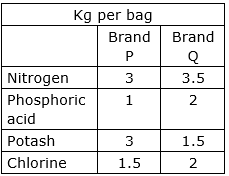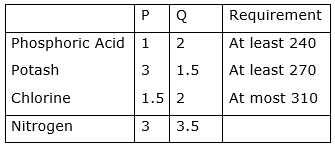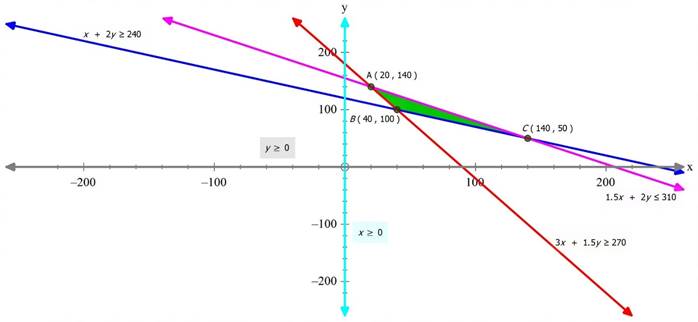A fruit grower can use two types of fertilizer in his garden, brand P and Q. The amounts (in kg) of nitrogen, phosphoric acid, potash, and chlorine in a bag of each brand are given in the table. Tests indicate that the garden needs at least 240 kg of phosphoric acid, at least 270 kg of potash and at most 310 kg of chlorine.

If the grower wants to minimize the amount of nitrogen added to the garden, how many bags of each brand should be used? What is the minimum amount of nitrogen added in the garden?
The above information can be expressed with the help of the following table:

Let the number of bags of P and Q chosen be ‘x’ and ‘y’ units.
Nitrogen from P = 3x
Nitrogen from Q = 3.5y
Nitrogen form the mixture = 3x + 3.5y
Now,
⟹ x + 2y ≥ 240
i.e. the minimum requirement of phosphoric acid in the mixture of P and Q is 240 kgs, each of which contains 1kg and 2kgs of phosphoric acid respectively
⟹ 3x + 1.5y ≥ 270
i.e. the minimum requirement of Potash in the mixture of P and Q is 270 kgs, each of which contains 3kgs and 1.5kgs of Potash respectively.
⟹ 1.5x + 2y ≤ 310
i.e. the maximum requirement of Chlorine in the mixture of P and Q is 310 kgs, each of which contains 1.5kgs and 2kgs of Chlorine respectively.
Hence, mathematical formulation of the LPP is as follows:
Find ‘x’ and ‘y’ that
Minimises Z = 3x + 3.5y
Subject to the following constraints:
(i) x + 2y ≥ 240
(ii) 3x + 1.5y ≥ 270
(iii) 1.5x + 2y ≤ 310
(iv) x,y ≥0 (∵ quantity cant be negative)

The feasible region is bounded (ABC)
The corner points of the feasible region is as follows:

Z is minimised at B(40,100)
The minimum amount of Nitrogen in the mixture is 470kgs